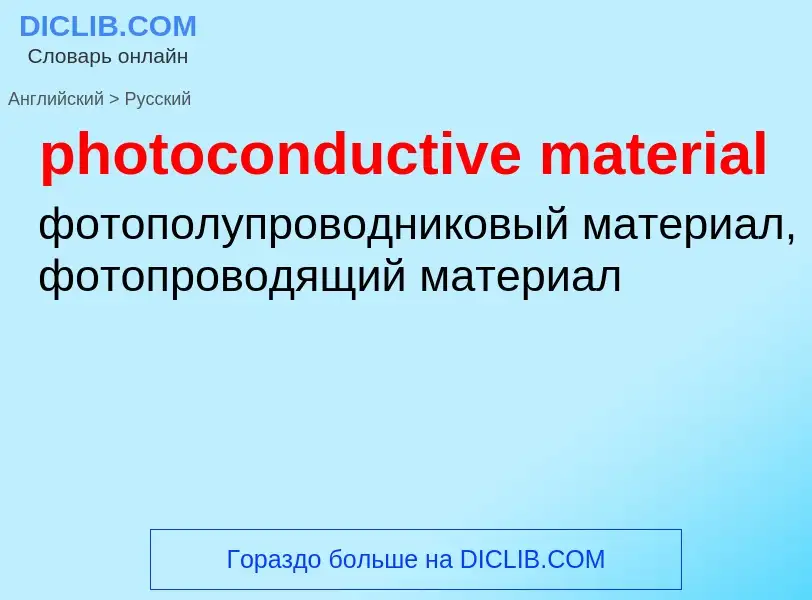Vertaling en analyse van woorden door kunstmatige intelligentie ChatGPT
Op deze pagina kunt u een gedetailleerde analyse krijgen van een woord of zin, geproduceerd met behulp van de beste kunstmatige intelligentietechnologie tot nu toe:
- hoe het woord wordt gebruikt
- gebruiksfrequentie
- het wordt vaker gebruikt in mondelinge of schriftelijke toespraken
- opties voor woordvertaling
- Gebruiksvoorbeelden (meerdere zinnen met vertaling)
- etymologie
photoconductive material - vertaling naar russisch
строительное дело
строительный камень (любая каменная порода, применяемая в строительстве)
общая лексика
стройматериалы
строительное дело
строительные материалы
Definitie
Wikipedia
Photoconductivity is an optical and electrical phenomenon in which a material becomes more electrically conductive due to the absorption of electromagnetic radiation such as visible light, ultraviolet light, infrared light, or gamma radiation.
When light is absorbed by a material such as a semiconductor, the number of free electrons and holes increases, resulting in increased electrical conductivity. To cause excitation, the light that strikes the semiconductor must have enough energy to raise electrons across the band gap, or to excite the impurities within the band gap. When a bias voltage and a load resistor are used in series with the semiconductor, a voltage drop across the load resistors can be measured when the change in electrical conductivity of the material varies the current through the circuit.
Classic examples of photoconductive materials include:
- photographic film: Kodachrome, Fujifilm, Agfachrome, Ilford, etc., based on silver sulfide and silver bromide.
- the conductive polymer polyvinylcarbazole, used extensively in photocopying (xerography);
- lead sulfide, used in infrared detection applications, such as the U.S. Sidewinder and Soviet (now Russian) Atoll heat-seeking missiles;
- selenium, employed in early television and xerography.
Molecular photoconductors include organic, inorganic, and – more rarely – coordination compounds.


![Copper belfry of St. Laurentius church, [[Bad Neuenahr-Ahrweiler]] Copper belfry of St. Laurentius church, [[Bad Neuenahr-Ahrweiler]]](https://commons.wikimedia.org/wiki/Special:FilePath/20130816 Belfry of St Laurentius Ahrweiler.jpg?width=200)
![firestop mortar]] at CIBC bank in [[Toronto]]. firestop mortar]] at CIBC bank in [[Toronto]].](https://commons.wikimedia.org/wiki/Special:FilePath/Celotex thermax foamed plastic sheets.jpg?width=200)
![[[Falkirk Wheel]] [[Falkirk Wheel]]](https://commons.wikimedia.org/wiki/Special:FilePath/FalkirkWheelSide 2004 SeanMcClean.jpg?width=200)
![The [[Gliwice Radio Tower]] (the second tallest wooden structure in the world) in [[Poland]] (2012). The [[Gliwice Radio Tower]] (the second tallest wooden structure in the world) in [[Poland]] (2012).](https://commons.wikimedia.org/wiki/Special:FilePath/Gliwice-radiostacja.jpg?width=200)
![pipes]] penetrating a [[concrete]] floor in a Canadian highrise apartment building pipes]] penetrating a [[concrete]] floor in a Canadian highrise apartment building](https://commons.wikimedia.org/wiki/Special:FilePath/Piping floor penetrations nortown casitas.jpg?width=200)


![Mohaves]] in a brush hut Mohaves]] in a brush hut](https://commons.wikimedia.org/wiki/Special:FilePath/View of a group of Mohaves in a brush hut, one man very emaciated, entitled, by Wittick, Ben, 1845-1903.jpg?width=200)

